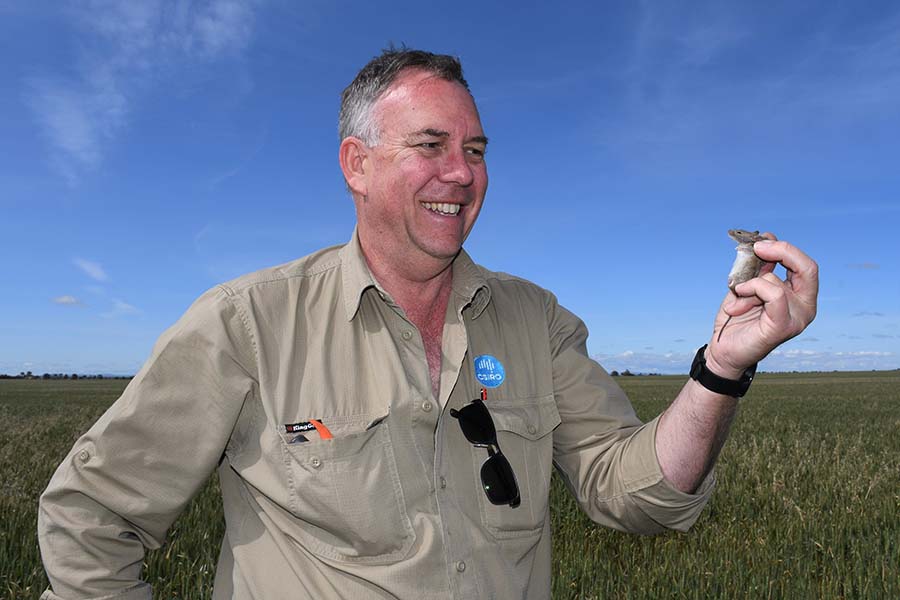Queensland grain growers are being advised to monitor mouse numbers, reduce the availability of food around silos and sheds and bait where needed with or before planting summer crops.
Researcher Steve Henry from CSIRO, Australia’s national science agency, spent last week monitoring and trapping mice at sites across southern Queensland and said numbers ranged from moderate to high.
Mr Henry, whose work is supported by GRDC, assessed on-farm sites at Brookstead, Allora, Felton, Moonie and Goondiwindi.
“The most active sites were in winter cereal stubble in cracking soils around Moonie, where our monitoring estimated 200 to 300 active burrows per hectare at some locations,” he says.
“These are not mind-boggling mouse numbers, but they are high enough to warrant growers being concerned and taking action before they plant summer crops.
“We know most are still waiting for sufficient rain to plant a summer crop, however, growers who are still planning to plant, need to be walking through paddocks to visually check for mouse activity.
“Mice will be attracted to freshly sown paddocks, so it is important that zinc phosphide is on the surface so it’s the first thing they come across.”
Mr Henry says controlling mouse numbers before summer crop emergence is important.
“Mice can do significant damage in a short amount of time in freshly sown and newly emerged crops, so baiting is inevitably a more economic option than replanting,” he said.
“But in the case where mice are doing damage to newly emerged crops it could be worth baiting in-crop and possibly in adjoining winter cereal stubble to try to reduce populations.”

CSIRO researcher Steve Henry said food resources left in paddocks post-harvest could sustain mouse breeding and lead to higher numbers through summer and into autumn winter crop planting. Photo: GRDC
Chinchilla agronomist Mark Llewellyn, from Wood Ag, says he has had had several clients report an ‘edge effect’ in recent weeks, where mice had caused damage as far as two to three planter widths into newly emerged sorghum crops.
“In this case, mice came out of winter crop stubble and into freshly sown paddocks and caused the damage,” he said.
“It’s a challenging situation given we have had limited planting opportunities due to a lack of rain and no one needs any early crop losses, so I am now advising my clients to monitor paddocks and bait if they see signs of mice.”
GRDC Crop Protection Manager – North and Darling Downs grain grower, Vicki Green, says even in moderate numbers mice could do serious damage to machinery wiring, so good grain hygiene and baiting around silos and sheds was important to keep numbers low.
“I am hearing increased reports of mouse problems across southern Queensland and the conditions are right for populations to increase through summer and into autumn, so we need to be savvy about monitoring and management,” Mrs Green says.
“Personally, we experienced significant damage in our wheat crop, but mouse numbers have since multiplied further and are now very problematic in and around our infrastructure.”
Researchers are also encouraging growers to keep tabs on mouse numbers on-farm to complement the official mouse monitoring system in place at select sites across the State.
“Breeding started in early spring, and forecast wet conditions through summer could result in current moderate populations swelling to relatively high densities in the coming months through to autumn,” Mr Henry said.
“Even within a relatively short geographic distance, there are significant differences between the levels of activity in paddocks due to the paddock history and available feed levels.
“So, growers are advised to monitor across multiple paddocks to gauge mouse numbers to inform management decisions, and mouse chew cards are useful for this task.”
Five mouse control tips:
- After harvest and prior to sowing – minimise sources of food and shelter: Control weeds and volunteer crops along fence lines, clean up residual grain by grazing or rolling stubbles.
- Apply broad scale zinc phosphide bait: According to the label, at the prescribed rate of one kilogram per hectare.
- Apply bait at seeding or within 24 hours: While seed is still covered by soil, increasing the likelihood of mice taking the bait, prior to finding the seed. Rebait through the season as needed.
- Timing is critical: Delays of 4-5 days in baiting after seeding can give mice time to find crop seed. High populations can cause up to five per cent damage each night.
- Monitor paddocks: Check paddocks regularly and update local data using the MouseAlert website.
Mr Henry urges growers to report and map mouse activity – presence and absence – using the MouseAlert website and via Twitter using @MouseAlert so other growers can see what activity is being observed in their neighbourhood.
Meanwhile, GRDC has invested in a major mouse-related research, development and extension program that is continuing to reveal new insights about mice in Australian broadacre cropping systems. The work is investigating mouse biology, ecology and bait efficacy.
Results from current research efforts will form the basis of a series of recommendations for improved mouse control strategies for Australian grain growers.
More information: control options are available via GRDC's Mouse Control page.

























































